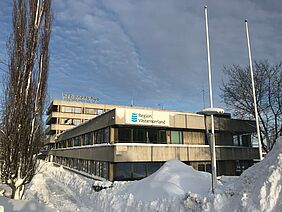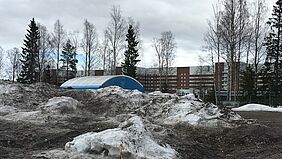We continue exploring the energy situation of the SMARCTIC project partner regions during the winter months. This week we travel to Sweden, to the region of Västernorrland, to speak with our project partner Marta Bystrowska from Region Västernorrland, to find out more about the energy sources and resources of local communities.
Marta Bystrowska | Sweden
In Västernorrland winters are long, cold, and dark. On the shortest day of the year there is only 5 hours of daylight. That makes December and January gloomy and dark months where people rather stay inside. Winters here are long, cold and darkry, with sub-zero temperatures lasting several months. There is also much more snow in Västernorrland comparing to southern Sweden, but less than inlands or the North. Winters can be quite snowy, but this is also changing over the last years as winters are becoming milder. Coastal areas of Västernorrland are generally warmer and with less snow than those located more inlands. Furthermore, over the last 10 years, there was between 140 and 160 days with snow cover per year in the region.
The snow has been successfully used over the last few years in the cooling system of the hospital in Sundsvall – when built in 2000 the facility was the first of its kind in the entire world. This innovative project uses new technology to utilize snow’s potential for cooling. Compared with the old system, electricity use has decreased by more than 90 percent and the environmentally hazardous refrigerants have largely been phased out. This in turn means that carbon dioxide emissions have also been reduced by 90 percent. You can read more about the project here (in Swedish) and in English.
As the cooling solutions are used in the summer, heating remains the biggest concern in winter. Around 60% of households’ energy use goes to heating.
Regarding heating, there are many existing solutions and the transition to using more efficient and sustainable ones can be observed in Sweden. Among the most popular are district heating. Sweden's district heating is mostly produced from environmentally friendly sources, so it is quite popular and a good choice. It is very common in cities but is also found in the countryside - it is mostly if there are many apartment buildings in the area.
In October 2020 the innovative project started in Härnösand, Västernorrland (where the regional Energy Office is also located) to build Europe’s biggest solar heating plant with concentrating solar collectors. When the plant is completed, 3,000 square meters of solar panels will produce one million kilowatt hours of solar heat per year. Read more in the press release here (in Swedish).
Family houses (there are about 2 million single-family homes in Sweden and 52,000 in Västernorrland) most often use different types of heat pumps. 60% of all detached houses in Sweden have some form of heat pump, rock and geothermal heat pumps to air-air or air-water heat pumps being among the most popular ones. Some of them are often complimented with direct electricity. Around 12% of households use just electric heating, but this also considered rather sustainable as, for example in Västernorrland all electricity comes from sustainable sources (water, wind). Pellet and wood are also used as heating sources.
Regarding energy sources and usage, it is observed that more and more households switch their heating to district heating and modern heat pumps because this reduces energy use from other sources. Heat pumps today primarily replace older heat pumps or direct-acting electricity / electric boilers, which means that this trend contributes to reduced electricity consumption. In Västernorrland the biggest interest is observed in rock heating (which might be expensive to install but gives good effects) and modern air-air/air-water heat pumps (With an air water heat pump, you can save up to 70 percent energy compared to more traditional solutions).


